In Burkina Faso, einem kleinen Dorf namens Gando, war er geboren und lernte, was es für viele bedeutet, ohne Schule zu leben: Diébédo Francis Kéré. Als Kind reiste er fast 40 Kilometer in das nächste Dorf, um zu lernen. Als Sohn des Dorfvorstehers wurde er aber gefördert, kam in die Stadt, erhielt eine Ausbildung zum Zimmermann, studierte Architektur in Berlin, gründete hier sein Büro. 2004 erhielt er den Aga Khan Award für die von ihm initiierte und gebaute erste Grundschule vor Ort: natürlich in Gando. Im Gespräch berichtet Francis Kéré von Bauen mit Lehm und von Architektur als sozialem Ereignis, fern vom Diktat der Globalisierung.
8. Dezember 2020 | Özlem Özdemir
Özlem Özdemir: Herr Kéré, Sie waren das erste Kind aus Ihrem Dorf, das zur Schule ging. Es folgte eine Ausbildung zum Tischler, danach gingen Sie nach Berlin, um Architektur zu studieren. Wie kam es dazu?
Diébédo Francis Kéré: Ein Jahr nach der Berufsausbildung habe ich gehört, dass der Deutsche Entwicklungsdienst Stipendiaten sucht. Und so bewarb ich mich und wurde auch genommen, und zwar in Berlin. Ich habe an eine Fortbildung teilgenommen, die dauerte zwei Jahre und ich sollte zurück nach Burkina Faso. Ich komme aber aus einer sehr großen Familie und die Erwartungen in der Heimat sind viel, viel größer als man sich das hier vorstellen kann. So beschloss ich, dazubleiben und zu schauen, dass ich eine standfestere Ausbildung mache. Es war ein Leben voller Hoffnung, voller Kämpfe, voller Unsicherheit. Man wusste ja nie, ob man das überhaupt schafft.
ÖÖ: Bekannt geworden sind Sie durch Ihr Diplomprojekt, eine Schule für Ihre Heimatdorf Gando.
DFK: Das Schulprojekt war eigentlich nicht meine Diplomarbeit. Ich habe nach dem zweiten Ausbildungsjahr, also bereits nach dem Grundstudium dieses Projekt entwickelt. Ich habe mich darauf konzentriert, alte Techniken zu studieren. Ich bin in Berlin und Umland unterwegs gewesen, herumgereist und habe alte Produktionsstätten von Ziegeln besucht und Gruben, wo man Lehm oder Ton gewonnen hat für Ziegel und Keramiken. Als ich nach einem Jahr Hauptstudium das Gefühl hatte, für meine Heimat, nicht für Architektur insgesamt, nur für meine Heimat, genug Wissen gesammelt zu haben, da wollte ich eigentlich gehen.
ÖÖ: Als Sie anfingen die Grundschule in Gando zu bauen, hat sie die ganze Dorfbevölkerung nicht ganz ernst genommen, stimmt das?
DFK: Ja, sie haben gesagt: „Mensch, Francis, hast du deinen Realitätssinn völlig verloren? Du weißt, dass ein Lehmgebäude nicht eine Regenzeit überstehen kann, eine ganz normale kleine Hütte übersteht ja kaum eine Regenzeit. Und jetzt kommst du und willst so was Großes, was normalerweise aus Beton oder Zement entsteht, aus Lehm bauen?“ Da waren sie wirklich sehr skeptisch. Aber, wir haben’s geschafft!

ÖÖ: Hat sich durch Ihre Architektur das Dorf verändert?
DFK: Mittlerweile ist meine Arbeit im ganzen Lande bekannt. Es ist so, dass die Leute in Gando natürlich sehr stolz sind, auf das was sie gemeinsam mit mir geschaffen haben. Wenn Gäste kommen, werden sie mittlerweile stolz und selbstbewusst durch die Baustellen geführt. Und zu den Schülern selbst: unsere Grundschule zählt zu den Besten im ganzen Lande. Manch ein Lehrer sagt, das hat mit den Gebäuden zu tun, mit dem Klima innerhalb der Räume, mit der ganzen Architektur, weil die Kinder sich wirklich sehr wohl fühlen und das befreit die Inspiration und die Kreativität.
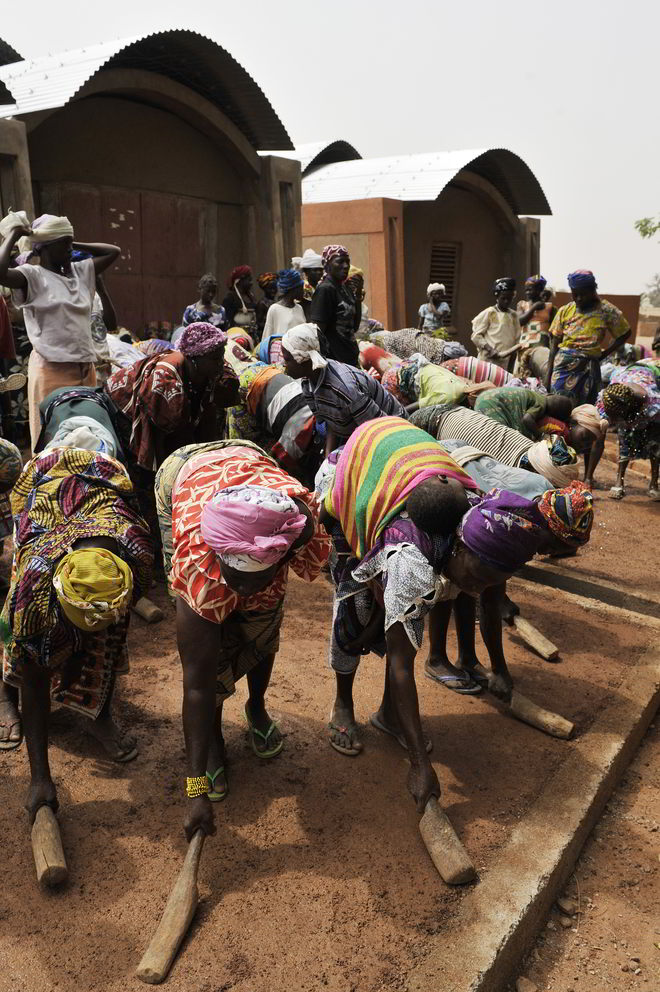
ÖÖ: Sie arbeiten nach einem Prinzip: Die meisten Bauwerke entstehen in Gemeinschaftsproduktion. Ist das aus der Not heraus geboren oder hat es traditionelle Gründe?
DFK: Beides. Ein Mann alleine oder eine Frau alleine kann nie die Fülle der Arbeit, die notwendig ist bei einem Hausbau, bewerkstelligen. Im Dorf haben wir noch Tauschwirtschaft. Du hilfst mir, meine kleine Hütte zu bauen und dann gebe ich dir zwei Hühner, dann koche ich Bohnen für die anderen Helfer. Gemeinschaftlich arbeiten ist die Grundlage meiner Kultur. Das ist das eine, aber ich wollte auch, dass das Gebäude mit wenig Geld errichtet wird. Heute sehe ich: Es ist sehr wichtig, dass die Gemeinschaft ihre Schule selbst baut. Die Schule ist kein Fremdkörper, auch wenn sie modern aussieht.
ÖÖ: Sie haben einmal etwas sehr Prägnantes gesagt: „Was vor Ort ist, wird zum Bauen genutzt.“
DFK: Das ist für mich eine Selbstverständlichkeit. Teure Sachen nur wenn es nicht anders geht, wenn es die Tragstruktur verlangt. Aber ansonsten ist es doch die einfachste Art und Weise zu bauen: Man nimmt, was am meisten vorhanden ist und macht daraus ein Gebäude. Genau das hat mich dazu geführt, Lehm einzusetzen.
ÖÖ: Sie haben für Ihr neues Projekt, dem „Collège de Gando“, ein Gymnasium für etwa 1000 Schüler, Lehm zu Fertigteilen verarbeitet. Wie kam es dazu?
DFK: Ich versuche immer wieder, Innovation zu schaffen. Bei der ersten Schule sind die Lehmsteine veredelt worden, indem ich dem Lehm bis zu acht Prozent Zement beigemengt habe. Bei der zweiten Schule wurde ich plötzlich vor vollendete Tatsachen gestellt. Also habe ich gesagt, wir machen es „tout-venant“, das bedeutet, den Lehm direkt aus der Grube und den Sand direkt aus dem Flussbett zu nehmen , zusammen zu mengen mit Kies und Zement und dann zu gießen wie Beton. Das würde den Arbeitsaufwand reduzieren. Man hat mehrere Tests gemacht. Das ist immer wichtig bei meiner Arbeit, die Leute sollen sehen, dass es läuft und dann (Kéré klatscht in die Hände, Anm.d.Red.) haben sie’s gemacht und es funktionierte. Dann bin ich abgezogen, sie sind geblieben und haben einfach alleine weitergemacht. So ist meine Arbeit!
ÖÖ: Wie wichtig ist Ihnen Wissenstransfer? Besser gefragt, wie bewusst ist Ihnen dieser Transfer?
DFK: Am Anfang gab es nur diesen Herzenswillen. Ich habe das als meine Aufgabe betrachtet, mich für die Belange der Gemeinschaft zu engagieren. Aber mittlerweile sehe ich, dass ich in der Arbeit eigentlich ganz unbewusst Wissen von Deutschland nach Gando übertrage, denn wir haben eine Menge Menschen geschult in den Bautechniken, und diese Leute verdienen Geld damit, indem sie auf mehrere Baustellen in Burkina Faso und auch in den Nachbarsländern arbeiten. Ich habe den Bauern beigebracht, wie man Lehmsteine einfach schichtet, wie man Lehm vorbereitet, bis hin, dass wir nun aus Lehm fast Betonwände herstellen können. Ich habe das unbewusst gemacht, ich habe so etwas nie geplant.
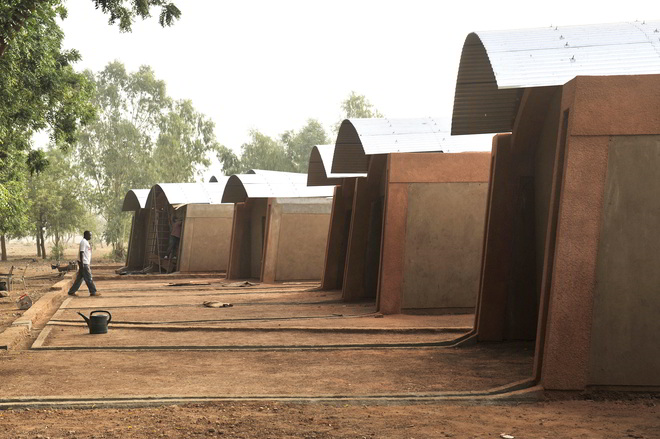
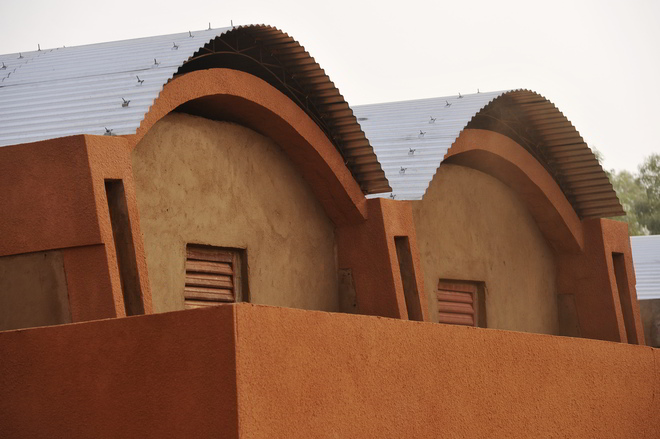
ÖÖ: Die Beziehung zwischen dem geografischen Klima Ihres Landes und dem Raumklima Ihrer Bauten ist zentral bei Ihnen. Die Lehrergebäude werden als die Kühlschränke von Gando bezeichnet.
DFK: (lacht) Das stimmt. Das Wichtigste ist natürlich für einen Klassenraum, dass das Klima darin das Lernen und das Lehren positiv beeinflusst. In einem Raum, in dem mehr als 40 Grad herrschen, können Kinder nicht lernen. Ich habe als Kind in einer solchen Klasse gesessen, das war ein Brutkasten. In meinen Bauten versuche ich dieses Klima zu verbessern. Daher habe ich Öffnungen, ein Doppeldach-System, damit eine natürliche Ventilation stattfindet. Denn wir können unmöglich in Burkina Faso, einem Land, welches zu den Ärmsten der Erde zählt, fossile Energie einsetzen, um Räume zu kühlen.
ÖÖ: Diese besondere Dachkonstruktion, die immer wiederkehrt in Ihrer Arbeit, wie Sind sie auf diese Idee gekommen?
DFK: Also, ich wollte ein großes Dach schaffen, um die Lehmwände gegen Erosion, gegen Regen zu schützen, aber gleichzeitig gegen Überhitzung durch Sonnenstrahlung. Dann sollte es auch Luftbewegung herbeiführen. Die Dachhaut ist sehr dünn und erhitzt sich sehr schnell. Und die Luft bleibt im Dachraum stecken. Aber da die Luft so heiß geworden ist und das Dach geneigt ist, entweicht sie durch die Öffnungen im Dachraum und die nachströmende Luft sorgt für Frische. Sie müssen eine Schule besuchen, Sie werden sagen: „Mensch, wo hat der den Ventilator versteckt?“ Sie müssen nur dafür sorgen, dass sie Lamellenfenster haben, dann strömt frische Luft nach. Ganz einfach!
ÖÖ: Mir ist beim Anblick Ihrer sehr charakterisitischen Dachkonstruktionen ein anderer Architekt eingefallen, der auch in einem heißen Kontinent arbeitet: Glenn Murcutt.
DFK: Glenn Murcutt ist mein großes Vorbild! Ich kenne ihn auch und bewundere seine Arbeit. Das erste Buch über einen noch lebenden Architekten, das ich mir gekauft habe, das war von Glenn Murcutt. Ich liebe seine Arbeit. Natürlich, Kritiker sagen, dass er zu teuer ist. Aber für mich sind seine Gebäude ganz klar lesbar. Da ist eine Klarheit in der Sprache, ganz leicht, nicht kompliziert.
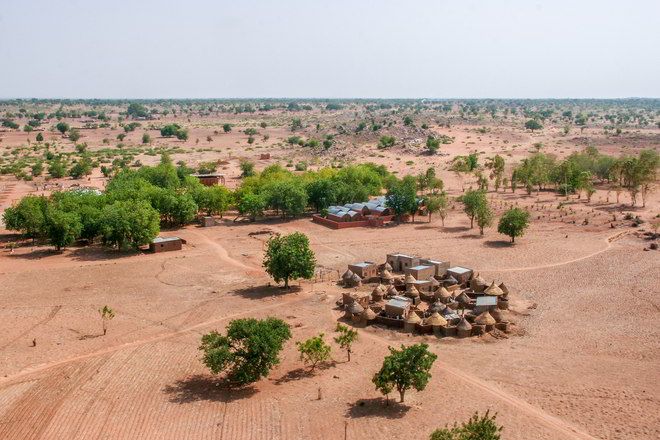
ÖÖ: Sehr viele Länder weisen eine lange Geschichte des Lehmbaus auf und trotzdem ist sie in der Gegenwartsarchitektur nicht stark vertreten. Wodurch könnte man den Lehmbau attraktiver machen?
DFK: Es ist nicht einfach, weil wir ein Diktat der globalen Architektur haben, der Baustoffe und der Formen. Jeder von uns ist gefragt, das zu tun, was lokal am besten funktioniert und nicht der Mode nachzueifern. Es ist an jedem von uns, dass er zweimal überlegt, Mensch, warum muss ich so bauen wie in New York? Es gibt sicherlich Nutzgebäude, die nicht anders funktionieren, die mit Lehm nicht zu bewerkstelligen sind, z.B. ein Flughafen oder ein Hochhaus. Wir müssen tätig werden und beispielhafte Lehmhäuser schaffen, dann wird es in Ländern, in denen Lehmarchitektur eine Tradition hat, auch wieder Mode, dass viele Leute gerne in Lehm leben.
ÖÖ: Wie kann man die Menschen davon überzeugen?
DFK: Wissen Sie, wenn wir eine Elite haben und wenn diese anfängt zu hüpfen, auf einem Bein und wir machen das nach, dann muss sich diese Elite auch ihrer Sache bewusst werden. Meistens haben wir nicht die Möglichkeit, diesen Trend richtig umzusetzen. Das ist der Fall in Burkina Faso, wir bauen Hochhäuser und wir können nicht mal gut mit Zement umgehen. Ich weiß auch, dass in einigen Ländern wie in Ägypten Gebäude einstürzen, weil man einfach nur ein Stockwerk immer und immer wieder aufgesetzt hat. Wenn jeder von uns anfängt, sich zu fragen, wohin führt diese Globalisierung der Architektur? Dann kann die Antwort nur lauten: Sie führt zur Einöde! Sie tötet die Kultur, die eigene Kultur. Und wenn es in einer Nation eine Lehmbautradition gibt, dann ist sie ein Teil der Kultur. Wenn sie verloren ist, dann haben wir uns selbst auch verloren. Das muss uns allen bewusst werden.
ÖÖ: Herr Kéré, herzlichen Dank für das Gespräch. ♦
Der Interview-Text wurde 2013 veröffentlicht bei Stylepark.com.
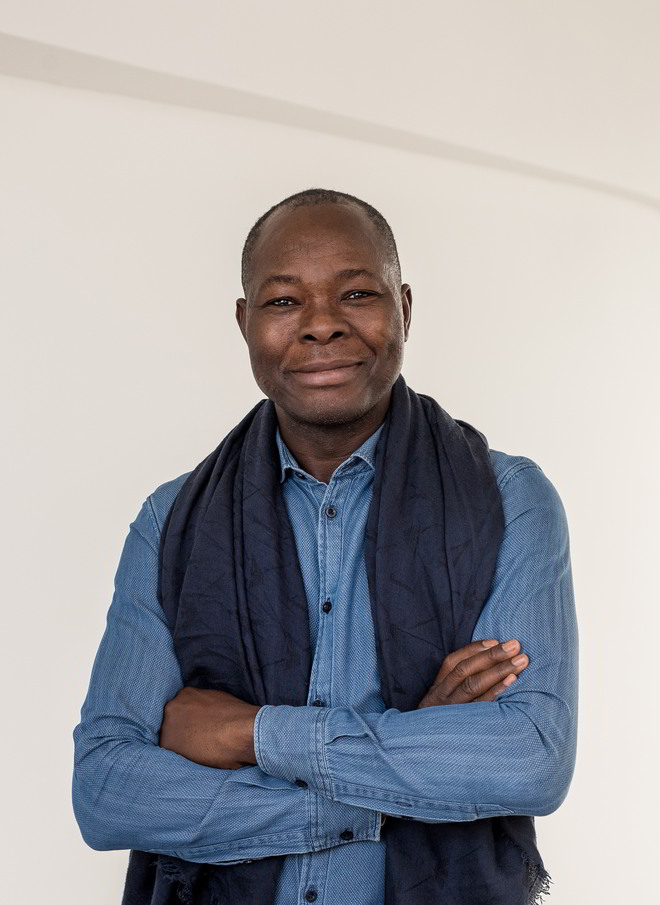
Zur Website von
KÉRÉ ARCHITECTURE
With a sense of reality and the will of the heart: Francis Kéré
He was born in Burkina Faso, a small village called Gando, and learned what it means for many to live without school: Diébédo Francis Kéré. As a child, he travelled almost 40 kilometres to the nearest village in order to learn. However, as the son of the village headman, he was given support, came to the city, obtained an apprenticeship as a carpenter, studied architecture in Berlin and founded his office here. In 2004 he received the Aga Khan Award for the first local elementary school built by him: of course in Gando. In this interview, Francis Kéré talks about building with clay and about architecture as a social event far from the dictates of globalization.
Özlem Özdemir: Mr. Kéré, you were the first child in your village to go to school. This was followed by an apprenticeship to become a carpenter, after which you went to Berlin to study Architecture. How did that all come about?
Diébédo Francis Kéré: A year after completing my vocational training I heard that the German Development Service was looking for fellows. And so I applied, my application was accepted, and was awarded a place to study in Berlin. After finishing a two-year advanced training course, I was supposed to go back to Burkina Faso. But I come from a very large family and the expectations at home are great, much greater than someone here could ever imagine. So I decided to stay and see if I could find a more stable traineeship. It was a life full of hope, full of struggles, full of uncertainty. You never knew if you were even going to survive it.
ÖÖ: You found renown thanks to your final university project, a school for your home village of Gando.
DFK: The school project wasn’t actually my final project. I developed the project after my second year at the university, after completing my foundation course. I concentrated on studying old techniques. I travelled around Berlin and the surrounding area visiting old brickworks and pits where they extracted the mud or clay to make the bricks and ceramics.
After graduating I felt like I had gained enough knowledge, not on architecture in general, but enough to help my homeland; that was the point when I actually wanted to go.
ÖÖ: The village didn’t take you seriously when you started building the primary school in Gando, is that right?
DFK: Yes, they said: “Man, Francis, have you completely lost your mind? You know that a mud hut can’t withstand a rainy season; an ordinary little hut barely survives a rainy season. And now you’ve come here and want to building something big, something that’s normally made of concrete or cement, using mud?!” They were extremely skeptical. But we did it!
ÖÖ: Did your architecture change the village?
DFK: My work is now known across the land. Of course, the people of Gando are very proud of what we achieved together. When guests come they are now shown around the construction sites with pride and confidence. And as for the pupils themselves: the school is considered one of the best in the whole country. Some of the teachers say that it is down to the buildings, to the climate in the rooms, to the architecture as a whole because the children really do feel comfortable there, which supplies inspiration and awakens their creativity.
ÖÖ: Your work is based on the principle that most buildings are the fruit of a collaboration. Is this a necessity or is it based on traditional ideas?
DFK: Both. One man or woman alone could never manage the workload that comes with constructing a building. We still have a barter economy in the village. You help me build my hut and I’ll give you two chickens, and cook beans for the helpers. Such a form of collaboration forms the very basis of my culture. That is one thing, but I also wanted to keep the cost of the build low. Today I see how very important it is that the community builds its own school. That way the school isn’t some kind of foreign body despite being very modern in appearance.
ÖÖ: You once said something very poignant: “We will use whatever is there to build.”
DFK: For me, this is self-evident. Expensive things should only be used when there is no other option, when they are necessary for the supporting structure. But otherwise this is the simplest way to build: You take what is most readily available and use it to construct a building. It is precisely this idea that led me to use mud.
ÖÖ: For your new project the “Collège de Gando”, a high school for around 1,000 students, you used mud to create prefabricated components. What prompted you to do this?
DFK: I am constantly trying to be innovative in my solutions. When building the first school I refined the mud bricks by mixing in up to eight percent cement. When it came to the second school I was suddenly presented with a fait accompli. So I said, let’s do it “tout-venant”, that means extracting the mud directly from the pit and the sand directly from the riverbed, mixing it with shingle and cement and then pouring it like cement. And this approach in fact reduces the amount of work. Several tests were carried out. That is always of great importance in my work – the people had to see that it actually works and then (Kéré claps his hands, editor’s note) they did it themselves and it worked then too. Then I left, and they stayed and just got on with the work on their own. That is the way things work with my buildings.
ÖÖ: How important is knowledge transfer to you? Or to put it more precisely, how aware are you if this transfer?
DFK: In the beginning all I had was the will in my heart. I saw it as my duty to commit myself to the needs of the community. But now I see that when while working I unconsciously transfer the knowledge I have gained in Germany to those in Gando. After all we have now trained a lot of people in construction techniques and this is now their bread and butter, working on other construction sites in Burkina Faso and neighboring countries. I taught the farmers how to lay mud bricks, how to prepare the mud, until we reached a point where we are now close to being able to make concrete walls using mud. But I did it unconsciously; I never planed to do something of this nature.
ÖÖ: The relationship between your country’s geographic climate and the room climate in your buildings forms a central aspect of your work. The teaching buildings are even described as “Gando’s fridges”.
DFK: (laughs) Indeed. The most important thing for a classroom is of course that the interior climate has a positive influence on the learning and teaching that takes place there. Children can’t learn in a room where it’s over 40 degrees. I sat in a room like that when I was a child, it was like an incubator. So I try to improve on this room climate in my own buildings. I have installed openings, a double-roofing system that allows for a natural ventilation flow. After all, using fossil-fueled energy to cool rooms just wasn’t an option in a country like Burkina Faso, one that is counted among the poorest on earth.
ÖÖ: This special roof that continually pops up in your work, how did you come up with the idea?
DFK: Well I wanted to create a large roof that would protect the mud walls against erosion and rain but simultaneously against overheating through solar radiation. The roof membrane is very thin and heats up very quickly. And the air becomes stuck in the roof space. But since the air has heated up so much and the roof is slanted, it escapes through the openings in the roof such that the inflowing air then cools the rooms. You have to visit one of the schools, and then you’ll find yourself asking: “Man, where did you put the AC unit?” You also have to make sure that they have lamella windows so that fresh air can flow in. Simple!
ÖÖ: Looking at several of your buildings, another architect who also works on a very hot continent came to mind: Glenn Murcutt.
DFK: Glenn Murcutt is my greatest role model! I know him and I really admire his work. The first book I ever bought by a living architect was by Glenn Murcutt. I love his work. Of course, critics say that he is too expensive. But I find his buildings clearly legible. They have a certain clarity in their form, very simple, uncomplicated.
ÖÖ: Lots of countries have their own tradition of building with mud and nonetheless it is not sufficiently represented in contemporary architecture. How could building with mud be made a more attractive option?
DFK: It’s certainly not easy, because there’s a dictate in global architect that governs the materials and forms used. We are all obligated to do that which works best in the given region and not to simply pander to current trends. It is down to each and every one of us to think about, why do I have to build like that in New York? Of course there are functional buildings that don’t work any other way, that just wouldn’t be able to fulfill their function if they were built with mud, e.g. airports or high rises. We have to act and create exemplary mud buildings; this way it will come back into fashion in countries that have a tradition in mud buildings and people will want to build with mud again.
ÖÖ: How can you convince people of this?
DFK: You know, if there is an elite and this elite group begins to hop around on one foot and we copy them; well, then this elite must also be aware of what they’re doing. In most cases we’re not in a position to implement these global trends in the proper way.That is certainly the case in Burkina Faso, we are building high rises yet we don’t really know how to work with cement. I also know that in some countries such as Egypt buildings are collapsing because they are simply building one story on top of another. If we all begin to ask ourselves where is this globalization of architecture leading? There is only one possible answer: It is creating a wasteland. It is killing cultures, our own cultures. And if a nation has a tradition of building with mud then that’s a part of their culture. If this is lost, then we will have also lost ourselves. That is something everyone should be clear on.
ÖÖ: Mr Kéré, thank you very much for the interview.
The interview text was published on Stylepark.com in 2013.
TRANSLATION BY: Gainestranslations.de






